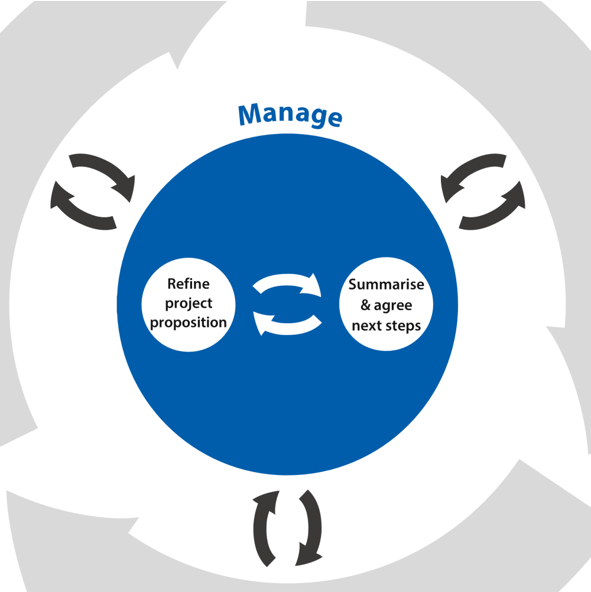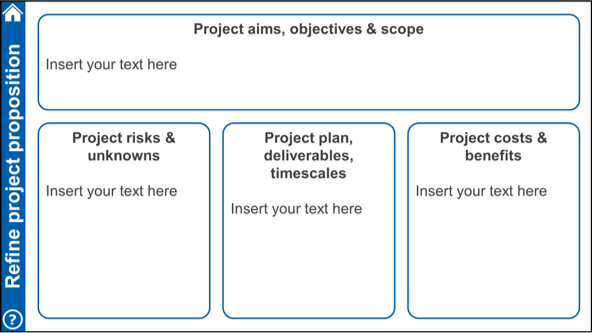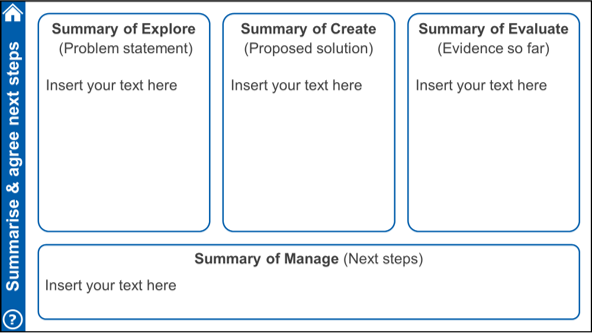The Manage phase reflects the decisions that need to be made about when, and which activities need to be performed. Two sources of project information should be implicitly or explicitly referred during this phase:
- The project proposition, which includes the project aims, objectives, risks, unknowns, plan and costs.
- The project summary, which includes the problem statement, the proposed solution(s), and the evidence gathered so far
Examining the project proposition and the project summary should help the team to identify the most appropriate 'next steps' activities that need to be completed in order to resolve the unknowns and progress the project. Each time a significant project event or decision takes place, the project proposition and the project summary should be checked or updated to reflect the new information or decisions made. This should then inform the decisions about which activities should be carried out next.
This page describes the activities within the Manage phase of the Inclusive Design Wheel in the particular context of transport service design.
On this page:
Manage activities answer the question ‘What should we do next?’. View full map.
Refine project proposition
The aim of this activity is to ensure that the project remains on track to meet its objectives, or, to get agreement to make explicit changes to these objectives. This grounding activity can be helpful as it is often easy to get stuck in the detail during the main phases of a project, making it difficult to see the way forward. Such difficulties can often be resolved by referring back to, or clarifying, the aim and objectives for the project. A clear statement of objectives can also be used to prevent subsequent decisions and compromises from eroding the concept's strength.
At the start of a project, the refining the project proposition activity involves identifying the project aims, objectives and scope. The following questions can help with this:
- Which people are currently being excluded, and why?
- What problem are we trying to solve?
- What are the potential barriers to success?
- (As the project develops) What is the proposed solution and how will it achieve the aims and objectives?
The blank template for the project proposition, which is available within the Inclusive design log for transport
Reducing the aims and objectives down to one or two sentences helps to capture the real essence of what the project is aiming to achieve. These statements should be outlined at the beginning of the project, and updated and refined throughout concept development.
As the project develops, risks, unknowns, costs, benefits can be identified, along with the evolving project plan, deliverables and timescales. Later on, this activity involves checking that the project is still on track to meet these aims and objectives. If not, the work can be modified to put it back on track, or explicit changes can be made to the aims and objectives. The project proposition slide additionally contains sections to capture this information:
- Project risks and unknowns
- Project plan, deliverables and timescales
- Project costs and benefits
These can help support the team in keeping track of where they are with their project.
Further information
- Keates’ (2006) book: ‘Designing for Accessibility: A Business Guide to Countering Design Exclusion’ contains a chapter on ‘Making the Business Case for Accessibility’. This may prove helpful in thinking through the business case for an inclusive design project. (Published by Routledge).
- The website of Association for Project Management offers project management resources, but requires membership.
- The website of Engineering Solutions On-Line offers a free Cost Benefit Analysis Template. This is an example of a generic cost-benefit tool, which may be helpful in thinking through some of the aspects of the business case.
Summarise & agree next steps
This activity involves examining the status of the project in the context of the work done so far and determining what to do next. The slide template captures the:
- Problem statement (which represents a summary of the Explore phase)
- Proposed solution(s) (which represents a summary of the Create phase)
- Evidence gathered so far (which represents a summary of the Evaluate phase)
At the start of the project, one or more of these aspects might be completely unknown, or might be based on estimations or assertions of the project team. As the project progresses, the level of confidence should increase.
To determine the 'next steps' consider the following questions, for each of the Explore, Create and Evaluate phases:
- What have we got?
- What are we missing?
- As a result, what are the highest priority next step actions?
The above questions should be considered in combination with the Project proposition, which was described in the previous panel.
The blank template for the project summary, which is available within the Inclusive design log for transport
Feedback
We would welcome your feedback on this page:
Privacy policy. If your feedback comments warrant follow-up communication, we will send you an email using the details you have provided. Feedback comments are anonymized and then stored on our file server. If you select the option to receive or contribute to the news bulletin, we will store your name and email address on our file server for the purposes of managing your subscription. You can unsubscribe and have your details deleted at any time, by using our Unsubscribe form. If you select the option to receive an activation code, we will store your name and email address on our fileserver indefinitely. This information will only be used to contact you for the specific purpose that you have indicated; it will not be shared. We use this personal information with your consent, which you can withdraw at any time.
Read more about how we use your personal data. Any e-mails that are sent or received are stored on our mail server for up to 24 months.




